In the fast-paced world of modern business, the relentless tide of tasks and processes can often feel overwhelming. Imagine this: you’re part of a bustling marketing team juggling numerous campaigns, each with deadlines, approvals, and content revisions. Your inbox is flooded with emails, spreadsheets, and project updates, making it a Herculean effort to keep everything on track.
Now, picture a colleague who seems to effortlessly manage the chaos, leaving you to wonder if they’ve somehow discovered the secret to a stress-free workday. Spoiler alert: They probably have, and it’s called workflow automation software.
Workflow automation is like having a personal assistant who never sleeps, never forgets, and never makes a mistake.
This guide will delve into the top 5 workflow automation software, explore their features and their pricing strategies.
What is Workflow Automation Software?
Workflow automation software is a digital tool or platform designed to streamline and optimize business processes by automating repetitive tasks, actions, and decisions within those processes. Its fundamental purpose is to enhance efficiency, reduce errors, increase productivity, and free up employees from time-consuming, manual work.
In essence, workflow automation software serves as a digital conductor, orchestrating the flow of work within an organization. It does this by defining, executing, and monitoring sequences of tasks and activities that make up various business processes. These processes can span across departments and functions, including HR, marketing, finance, customer service, and more.
Workflow automation software like Nanonets takes the concept a step further by integrating advanced technologies such as natural language processing and large language models (LLMs). This allows users to create and run workflows using simple, conversational language, making the automation process more intuitive and accessible. With the ability to connect various applications, databases, and documents, Nanonets enables the creation of unified workflows that seamlessly automate manual tasks across different platforms. Furthermore, it leverages custom LLMs to perform complex functions like writing texts, posting responses, and executing Retrieve and Generate (RAG) workflows within applications. This versatility enhances the adaptability of workflows to different business needs.
An innovative feature of this software is the incorporation of both human and automated approval or validation stages. This hybrid approach ensures that workflows are not only automated but also maintain a level of human oversight for accuracy and effectiveness. This can be tough to achieve with traditional workflow automation softwares and hence results as a drawback. The result is a more reliable and efficient workflow, tailored to the specific requirements and nuances of each business process. By combining the speed and consistency of automation with the discernment and flexibility of human input, Nanonets represents a significant evolution in the field of workflow automation, making it an indispensable tool for modern businesses seeking to optimize their operations.
How to Automate your Workflows?
Automating your workflows is a strategic approach to enhance efficiency and accuracy in business processes. This process involves several key steps:
- Select the Process for Automation: Begin by pinpointing the specific business process you want to automate. This could be anything from routine data entry to complex, multi-step operations involving several participants.
- Detail the Process: After selecting the process, break it down into smaller, manageable segments. Detail each step, understanding the inputs, outputs, and relationships involved. This detailed mapping is crucial for identifying automation opportunities and selecting the right tools.
- Choose Suitable Automation Tools: With a clear understanding of the process, select the appropriate automation tools. These might range from simple software solutions to more sophisticated robotic process automation (RPA) systems.
- Design the Automation Strategy: Design your automation by developing the necessary scripts or program logic. This design should align with the detailed process map, considering all the dependencies and data flows identified earlier.
- Implement the Automation: Roll out the designed automation by setting up and configuring the selected tools. This step involves integrating these tools with existing systems and applications involved in the workflow.
- Test the Automation: Before full deployment, rigorously test the automation using sample data to ensure it operates as expected. This testing phase helps identify and rectify any errors or issues in the automation logic.
- Monitor and Update as Needed: Post-implementation, continuously monitor the performance of your automated workflows. Be proactive in identifying any issues or areas for improvement, and update the automation logic to adapt to changing needs or to rectify any issues.
By following these steps, you can effectively automate your workflows, leading to more streamlined processes, fewer errors, and freeing up valuable time for employees to focus on higher-level tasks. This systematic approach to automation helps in achieving greater operational efficiency and enhances overall business performance.
Benefits of Workflow Automation Software
- Time Savings: Workflow automation software dramatically reduces the time required to complete tasks and processes by eliminating manual intervention and streamlining workflows. This results in faster project delivery, quicker response times, and overall time efficiency for organizations.
- Increased Productivity: Automation liberates employees from mundane and repetitive tasks, allowing them to focus on more strategic and value-added activities. This boost in productivity can lead to a more motivated workforce and increased output without the need for additional personnel.
- Reduced Errors: Human errors, such as data entry mistakes or oversight, are common in manual processes. Workflow automation minimizes these errors by enforcing consistent procedures and automating data handling, resulting in improved accuracy and reduced costly mistakes.
- Enhanced Collaboration: Automation facilitates seamless communication and collaboration among team members and departments. By automatically routing tasks and information to the right individuals at the right time, organizations can foster effective teamwork, even in remote or distributed work environments.
- Scalability: As organizations grow, the demands on their processes increase. Workflow automation software scales effortlessly to accommodate expanded workloads, ensuring that efficiency and productivity can be maintained even during periods of growth.
- Cost Savings: Through reduced labor costs and operational expenses, workflow automation directly contributes to cost savings. It eliminates the need for additional administrative staff to manage manual processes and minimizes costs associated with paper-based workflows.
- Consistency and Compliance: Automation enforces standardized processes, ensuring that tasks are completed consistently and in accordance with established rules and regulations. This consistency is vital for compliance with industry standards and legal requirements.
- Data Accessibility: Automated workflows often centralize data, making it easily accessible to authorized users when needed. This accessibility not only enhances decision-making but also simplifies reporting, analytics, and information retrieval.
- Customer Satisfaction: Workflow automation leads to faster response times and fewer errors in customer interactions. This improved service quality enhances customer satisfaction, as clients benefit from quicker order processing, issue resolution, and access to accurate information.
- Strategic Insights: With workflow analytics and reporting capabilities, organizations gain valuable insights into process performance. This data enables them to identify bottlenecks, fine-tune workflows, and make data-driven decisions to improve operations.
- Competitive Advantage: Businesses that adopt workflow automation gain a competitive edge by becoming more agile and responsive. They can adapt quickly to changing market dynamics and customer needs, positioning themselves as leaders in their industries.
- Employee Satisfaction: Employees appreciate workflow automation for its ability to reduce their administrative workload, allowing them to engage in tasks that demand creativity and critical thinking. This can boost morale and overall job satisfaction.
Key Attributes of Effective Workflow Automation Software
There is no shortage of workflow automation tools in the market. Selecting the right workflow automation tool is essential. Here are the essential attributes to consider when choosing workflow automation software:
- User-Friendly Design and Construction: The software should facilitate easy workflow creation, preferably with a visual, drag-and-drop interface. Opt for low-code platforms that simplify the construction of even the most intricate processes into visual flowcharts, laying the groundwork for efficient workflow automation.
- Cloud-Enabled: Opt for cloud-based solutions over traditional on-premise ones. Cloud platforms generally offer superior accessibility, reliability, and data security, making them a more advantageous choice for workflow automation.
- Seamless Integration with Other Systems: Ensure that the software can effortlessly integrate with other critical business systems such as ERP and CRM, ideally through established API tools like Zapier. This integration capability is vital for creating a cohesive workflow environment.
- High Customization Potential: The software should be adaptable to suit various business requirements, capable of managing both straightforward and complex workflows with ease.
- Advanced Reporting and Analytics: Access to comprehensive data reports and process analytics is crucial. The software should provide centralized, user-friendly access to these insights, aiding in process refinement and business strategy optimization.
- Robust Data Security: Data protection is paramount. The ideal software will offer top-notch security features, including end-to-end encryption, to safeguard sensitive business information.
- Cost-Effective Pricing Structure: Consider software that offers a pricing model aligned with your usage and user count, including costs for implementation, consultation, and ongoing support.
For example, Nanonets is a versatile workflow automation tool designed to swiftly set up workflows and build forms. It boasts a comprehensive set of features tailored for automating tasks across various business functions such as HR, Sales, Finance, Administration, IT, Marketing, and Purchasing. This makes it an ideal choice for businesses seeking a robust, all-encompassing workflow automation solution.
Nanonets makes automation simple. Elevate your productivity effortlessly and redefine the way you work.
Top 10 Workflow Automation Software
#1: Nanonets
Nanonets’ workflow automation offers a new platform that can harnesses the power of advanced artificial intelligence (AI). It enables businesses to craft, refine, and automate complex workflows with unprecedented ease. Central to its appeal is the ability to use natural language for creating and running workflows that interact seamlessly with all your apps and data. This feature makes Nanonets highly accessible and user-friendly, even for those without technical expertise.
Another key aspect of Nanonets is its capacity to connect apps, databases, and documents, thus facilitating the creation of unified workflows that efficiently automate manual tasks. This interconnectedness ensures a smooth flow of data across various platforms, enhancing overall process efficiency.
Moreover, Nanonets steps up its game by allowing the building and usage of custom large language models (LLMs). These models are adept at writing texts, posting responses, and executing Retrieve and Generate (RAG) workflows within applications, showcasing a high degree of adaptability and intelligence.
A distinctive feature of Nanonets is its integration of both human and automated approval or validation stages in workflows. This blended approach not only streamlines processes but also ensures greater accuracy and effectiveness, catering to the nuanced needs of various businesses.
In essence, Nanonets is an ideal solution for enterprises looking to inject efficiency and accuracy into their manual processes through smart, AI-driven automation.
Workflow Automation on Nanonets
Pros of Nanonets:
- Effortless Workflow Creation: Nanonets empowers users to craft custom workflows swiftly, often accomplishing the task in under 15 minutes. This rapid workflow deployment ensures that organizations can adapt to ever-changing needs and seize new opportunities promptly.
- Vast Integration Ecosystem: With the ability to seamlessly connect with over 100+ applications, Nanonets breaks down silos, enabling organizations to integrate their preferred tools and systems effortlessly. You can raise a custom requirement as well and Nanonets can share a demo video of your workflow integration in real time.
- Pre-built Workflow Templates: Nanonets doesn’t just start from scratch; it provides an extensive library of pre-built workflow templates. These templates cover a spectrum of common use cases, providing a convenient starting point for organizations seeking rapid automation solutions.
- Intuitive User Interface: The platform boasts a modern user interface with an intuitive design. This user-friendly approach ensures that both novices and seasoned professionals can navigate the platform with ease.
- No-code Platform: Nanonets shines as a no-code platform, enabling users with diverse technical backgrounds to create complex workflows and automation processes without the need for coding expertise.
- Flexible Logic Functions: Users can mold their workflows with precision, crafting complex logic functions on the fly. Nanonets empowers organizations to tailor their automation solutions to meet their specific requirements without cumbersome coding hurdles.
- Dynamic Workflow Modification: The ability to modify workflows on the go means that organizations can stay agile and responsive to changing business needs, optimizing their processes with agility.
- Role-based Access Control: Nanonets provides role-based access control, ensuring that the right individuals have access to the right workflows and data. This feature enhances security and data privacy.
- Detailed Workflow Analytics: Gain valuable insights into workflow performance with Nanonets’ detailed analytics. Organizations can track key metrics, identify bottlenecks, and continuously refine their automation strategies.
- Transparent Pricing: Nanonets adopts a transparent pricing structure, allowing organizations to budget effectively and avoid unexpected costs.
- 24×7 Technical Support: With round-the-clock technical support, Nanonets ensures that organizations have assistance when they need it, minimizing downtime and disruptions.
- Free Migration Assistance: Transitioning to Nanonets is made smoother with free migration assistance, helping organizations seamlessly migrate their existing processes to the platform.
Pricing:
- Custom Plan: Pricing is dynamic based on custom requirements. Typically charges are applicable on each workflow “block” being run. Schedule a call with Nanonets and find out more.
- Custom Enterprise Plan: Nanonets also offers a custom plan for enterprises with specific needs. The custom plan requires a specific quote from Nanonets to build and price and includes upper-end features like a dedicated account manager, custom data retention, customized client onboarding, and personalized 1:1 team training.
Nanonets workflows can optimize your business performance, save costs and boost growth. See how Nanonets’ use cases can apply to your product.
#2: Microsoft Power Automate
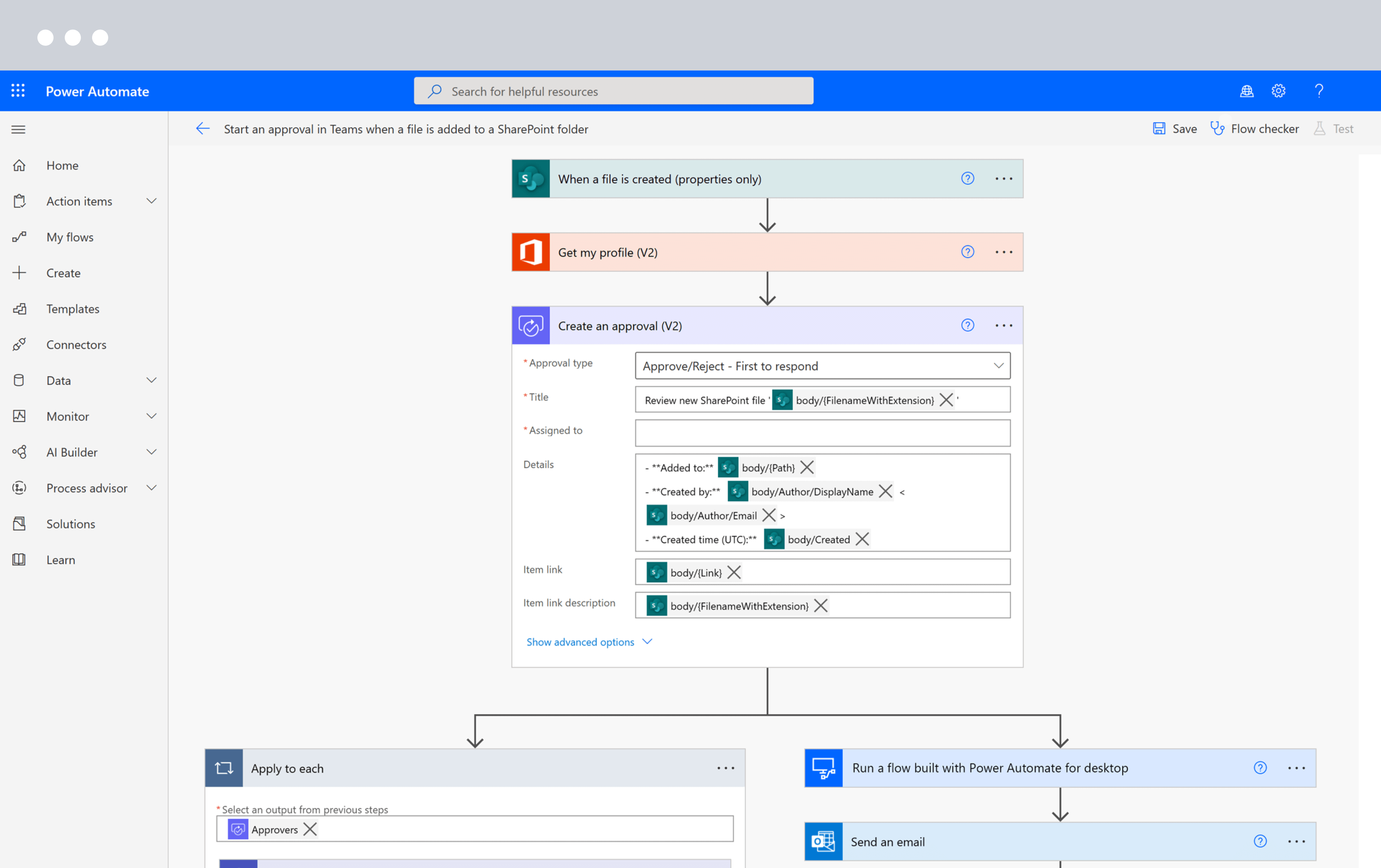
Microsoft Power Automate, formerly known as Microsoft Flow, is a cloud-based workflow automation platform developed by Microsoft. It empowers organizations to create, automate, and optimize workflows and processes by seamlessly connecting various applications and services. With Power Automate, users can design workflows to automate repetitive tasks, trigger actions based on specific conditions, and integrate Microsoft 365 apps and other third-party services.
Pros of Power Automate:
- Integration with Microsoft 365: Power Automate seamlessly integrates with Microsoft’s suite of productivity tools, including SharePoint, Outlook, Teams, and more, making it a powerful choice for organizations already using these services.
- User-Friendly Interface: Power Automate provides a user-friendly, no-code or low-code interface, enabling users with varying technical expertise to create and customize workflows without extensive coding knowledge.
- Extensive Connector Library: The platform offers a vast library of connectors to various third-party apps and services, making it versatile for automating a wide range of processes across different applications.
- Pre-built Templates: Power Automate includes a collection of pre-built templates for common business processes, allowing users to get started quickly and customize workflows to their specific needs.
- Enterprise-Level Security: Microsoft places a strong emphasis on security and compliance. Power Automate benefits from Microsoft’s robust security measures, ensuring the protection of sensitive data and compliance with industry standards.
- Advanced Workflows: Power Automate provides advanced capabilities for complex workflows, including support for custom expressions, loops, and conditional branching.
- Approval Workflows: It offers built-in approval workflows, which are valuable for processes that require manager or stakeholder approvals.
Cons of Power Automate:
- Pricing Complexity: Power Automate’s pricing can be complex, as it offers different plans with varying levels of features and usage allowances. Users should carefully assess their needs to choose the right plan.
- Premium Connectors: Some advanced features and connectors, such as those for on-premises data or premium applications, may require additional licensing or incur extra costs.
- Learning Curve: While it’s designed to be user-friendly, users with limited automation experience may still face a learning curve, especially when creating complex workflows.
- Limited Functionality in Free Plan: The free plan of Power Automate has limitations on the number of runs and connectors available, which may not be sufficient for larger organizations or extensive automation needs.
Pricing
Pricing plans start at $15/month/user
#3: Zapier
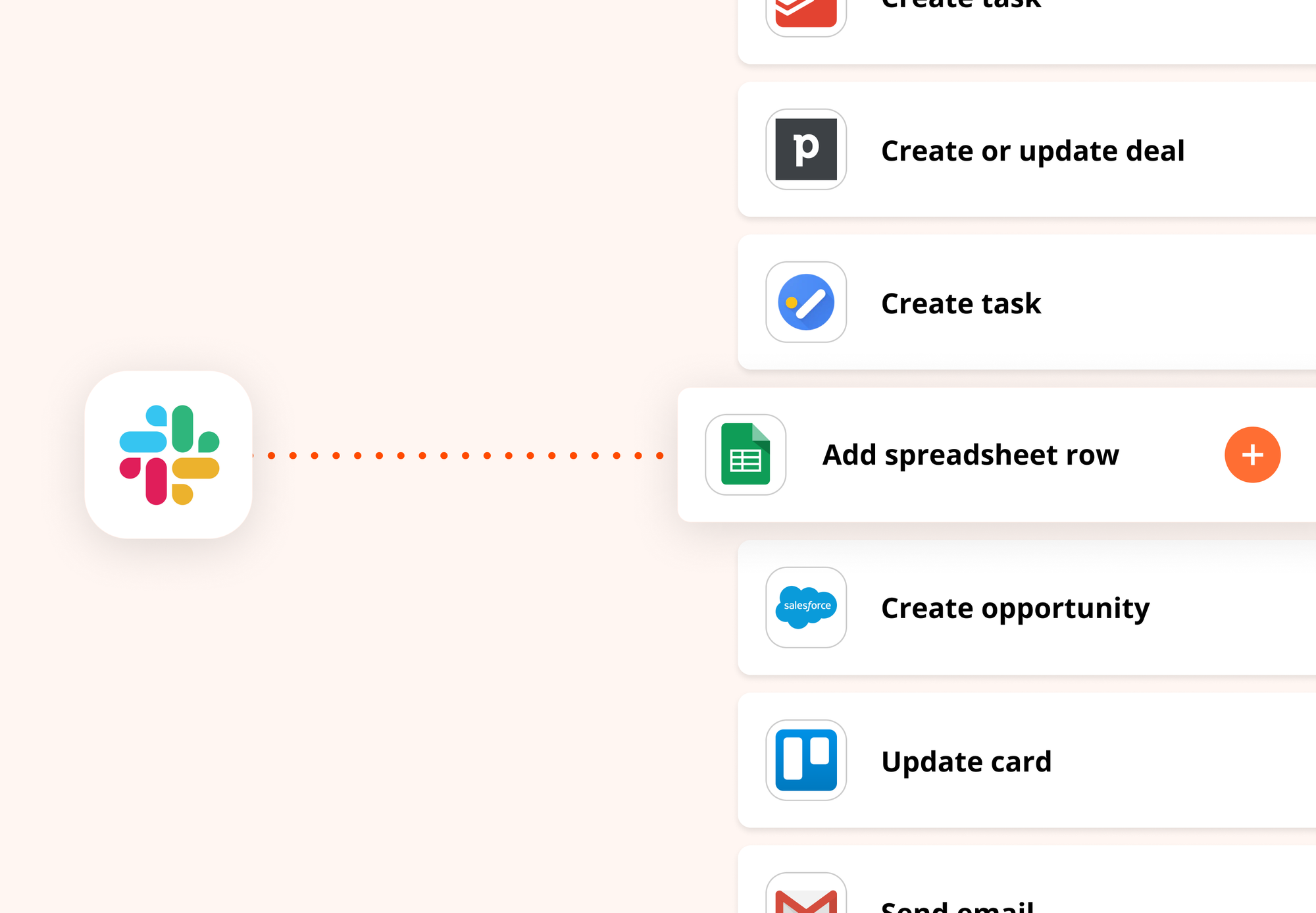
Zapier empowers individuals and organizations to connect their favorite apps and automate repetitive tasks with remarkable ease. Think of it as the bridge that seamlessly links thousands of web applications, enabling users to create automated workflows, known as “Zaps,” without any need for complex coding or technical expertise. Zapier’s user-friendly interface and extensive app integrations have made it a go-to solution for streamlining processes, boosting productivity, and bringing efficiency to the forefront of daily operations.
Pros of Zapier:
- Extensive App Integration: Zapier boasts a vast ecosystem of over 3,000 app integrations, spanning across diverse categories such as productivity, marketing, finance, and more. This wide range of connections provides users with the flexibility to automate a plethora of tasks and processes.
- User-Friendly Interface: Zapier’s intuitive interface simplifies the automation process, making it accessible to individuals with varying technical backgrounds. Users can create Zaps through a straightforward visual builder, eliminating the need for coding skills.
- Versatility: Zapier’s versatility shines through the creation of custom Zaps. Users can tailor their workflows to meet specific needs, whether it’s automating email marketing, lead management, data synchronization, or even social media posting.
- Notification and Alerts: Zapier enables users to set up notifications and alerts for various triggers and actions. This feature ensures that important events or tasks are never missed, enhancing efficiency and responsiveness.
- Multi-step Workflows: Users can create multi-step Zaps to execute complex processes. This allows for the automation of entire sequences of actions, enabling users to streamline intricate workflows effortlessly.
- Synchronization Across Platforms: Zapier’s ability to synchronize data across different platforms ensures that information is consistently updated and available where it’s needed most. This is particularly valuable for organizations with multiple software systems.
- No-Code Automation: Zapier’s no-code approach makes automation accessible to a wide audience. Users don’t need to possess programming skills to create effective Zaps, democratizing the automation process.
Cons of Zapier:
- Cost Considerations: While Zapier offers a free plan, users with more extensive automation needs may find that they need to upgrade to a paid plan, which can incur additional costs.
- Complex Zaps May Require Testing: More complex Zaps might require testing and troubleshooting to ensure that all elements work seamlessly. Users may need to invest time in refining and fine-tuning their workflows.
- Limited Customization for Free Plan: The free plan of Zapier has limitations in terms of the number of Zaps and the frequency of updates, which may not be sufficient for larger organizations or extensive automation requirements.
Looking for document data extraction and OCR in Zapier? Look no further! Try Nanonets today.
Pricing:
- Free Plan
Cost: Free
Features: Single-step Zaps, no-code editor, 100 tasks per month. - Starter Plan
Cost: $19.99 per month (billed annually)
Features: Multi-step Zaps, Filters and Formatter, Versions, 750 tasks per month. - Professional Plan
Cost: $49.99 per month (billed annually)
Features: Unlimited Premium Apps, Autoreplay, Custom Logic with Paths, 2,000 tasks per month. - Team Plan
Cost: $74.99 per month (billed annually)
Features: Unlimited users, Premier support, Shared app connections, Live chat, 2,000 tasks per month.
#4: Kissflow

Kissflow is a versatile cloud-based workflow automation and business process management (BPM) platform designed to empower organizations of all sizes to streamline their operations and enhance productivity. With an intuitive no-code approach, Kissflow enables users to create, manage, and automate workflows and business processes effortlessly. Whether it’s automating approval workflows, managing projects, or handling procurement processes, Kissflow provides a user-friendly environment to optimize processes and foster collaboration across teams.
Pros of Kissflow:
- No-Code Workflow Creation: Kissflow’s no-code platform allows users with varying technical expertise to design and implement workflows without the need for programming skills. This accessibility democratizes the automation process.
- Wide Range of Integrations: Kissflow integrates seamlessly with numerous third-party applications and services, enhancing its versatility and compatibility with existing tools and systems.
- User-Friendly Interface: The platform boasts an intuitive and visually appealing interface that simplifies the process of designing, deploying, and managing workflows, reducing the learning curve for users.
- Process Analytics and Reporting: Kissflow offers robust analytics and reporting features that enable users to gain insights into process performance. This data-driven approach facilitates continuous process improvement.
- Collaboration and Communication: The platform promotes collaboration through features like task assignments, real-time notifications, and discussion threads, ensuring that teams can work together efficiently within workflows.
- Mobile Accessibility: Kissflow is accessible on mobile devices, allowing users to manage workflows and stay connected, even when they’re on the go.
- Compliance and Security: The platform offers compliance features and adheres to robust security standards, ensuring data privacy and regulatory compliance.
- Scalability: Kissflow accommodates the growth of businesses, making it suitable for both small enterprises and larger organizations.
Cons of Kissflow:
- Complex Workflows May Require Expertise: While Kissflow is designed to be user-friendly, complex workflows with intricate business logic may require the assistance of experienced BPM professionals.
- Pricing Considerations: The pricing structure for Kissflow can vary based on the number of users and specific features required, so organizations need to carefully assess their needs and budget accordingly.
- Limited Advanced Features in Lower Tiers: Some advanced features may only be available in higher-tier plans, which could impact the functionality available to users on lower-priced plans.
Pricing:
Pricing starts at $1500/month
Looking for a simple workflow automation solution? Try Nanonets. No-code. No-hassle. Create workflows that work.
#5: HubSpot
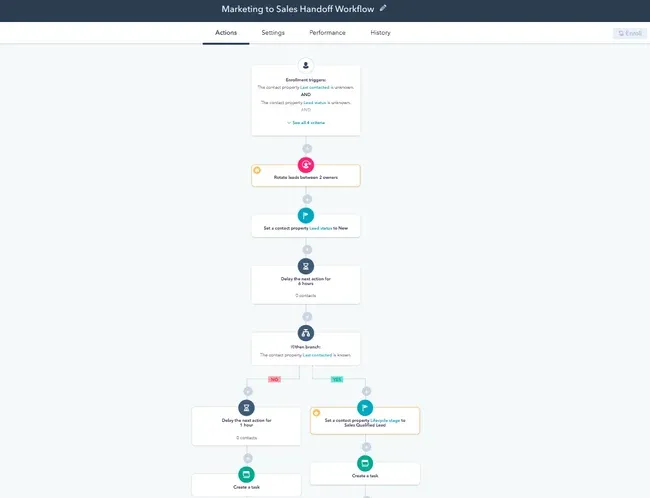
HubSpot is a leading customer relationship management (CRM) and inbound marketing platform that empowers businesses to attract, engage, and delight their customers. It offers a comprehensive suite of tools and features designed to streamline marketing, sales, and customer service activities. HubSpot is renowned for its user-friendly interface and the ability to integrate various aspects of a company’s customer interactions into a single platform, helping businesses grow and nurture their customer relationships.
Pros of HubSpot:
- All-in-One Solution: HubSpot provides an integrated platform that covers marketing, sales, and customer service, allowing businesses to manage their entire customer lifecycle from a single interface.
- User-Friendly: HubSpot’s intuitive interface makes it accessible to users with varying technical expertise, reducing the learning curve for new users.
- Marketing Automation: HubSpot offers robust marketing automation tools, enabling businesses to create and execute automated marketing campaigns, email workflows, and lead nurturing processes.
- Sales Enablement: HubSpot equips sales teams with features like lead scoring, email tracking, and sales automation, helping them close deals more efficiently.
- Customer Relationship Management (CRM): The built-in CRM system allows businesses to manage contacts, track interactions, and gain valuable insights into customer behavior.
- Content Management: HubSpot’s content management system (CMS) simplifies website creation and management, making it easy to create and optimize web content.
- Analytics and Reporting: Detailed analytics and reporting features help businesses track the performance of marketing and sales efforts, enabling data-driven decision-making.
- Personalization: HubSpot enables personalized marketing and customer interactions, enhancing engagement and conversion rates.
- Integration Ecosystem: HubSpot integrates with numerous third-party applications and services, allowing businesses to connect their favorite tools and extend functionality.
Cons of HubSpot:
- Pricing: While HubSpot offers a free CRM and basic marketing tools, more advanced features and scaling may require higher-tier plans, which can be relatively expensive.
- Complexity for Large Enterprises: While HubSpot is suitable for businesses of all sizes, it may not provide the depth of features required by large enterprises with complex needs.
- Learning Curve for Advanced Features: Utilizing the full range of HubSpot’s features, especially its more advanced marketing automation capabilities, may require significant training and expertise.
- Content Limitations: The CMS may have limitations for organizations with very large or complex websites, which may require additional customization.
Pricing:
The Starter Plan starts at $18/month.
#6: monday.com
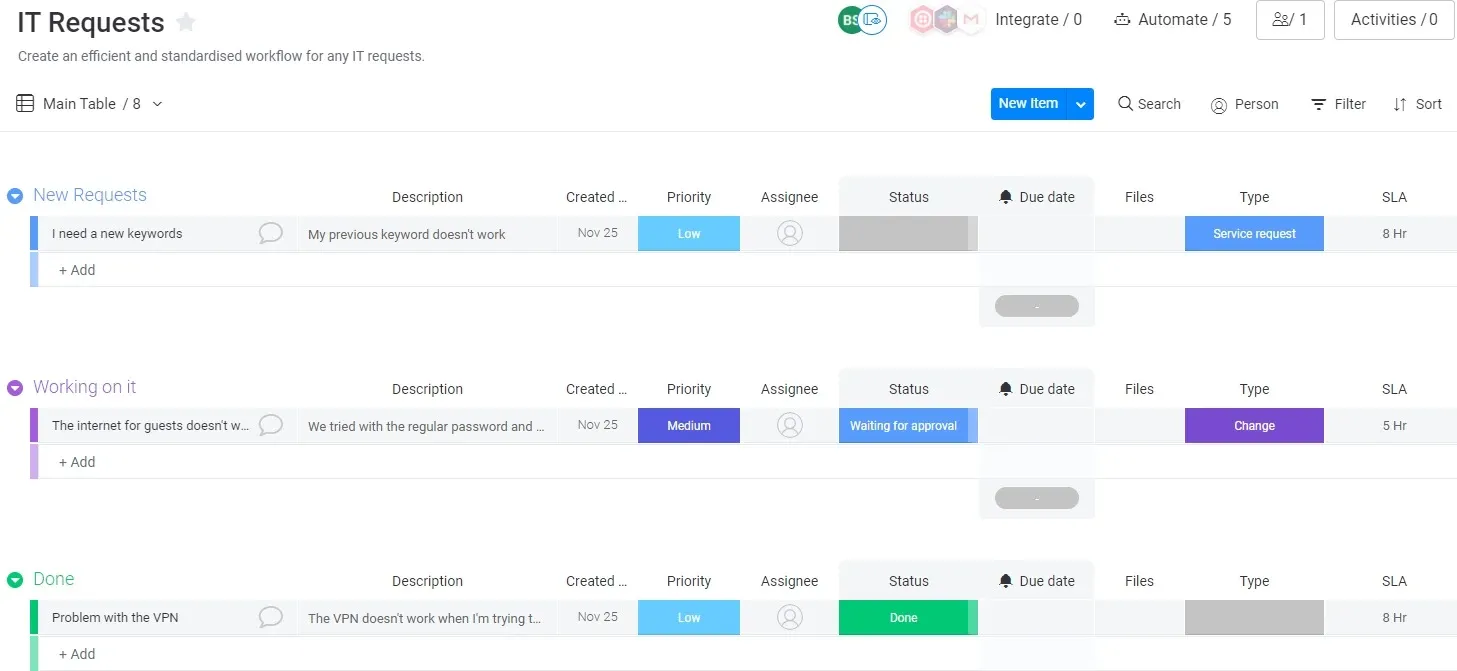
monday.com positions itself as a comprehensive work management platform, notable for its exceptional automation module designed to boost productivity. This platform excels in eliminating repetitive tasks and standardizing processes, making workflow management both efficient and consistent.
Why monday.com Stands Out: The platform has garnered significant attention through its marketing efforts, and it doesn’t disappoint. The automation capabilities within monday.com are impressively sophisticated. The automation builder is user-friendly, enabling the creation of numerous automations swiftly. Users have the flexibility to craft custom automations or choose from a plethora of pre-designed templates. Moreover, the reach of these automations extends beyond the platform itself, integrating seamlessly with other tools like Slack and Clearbit.
One of the most appealing aspects of monday.com is the universal availability of these automations across all its versions, including work, development, and sales modules. This uniformity ensures a consistent experience regardless of the specific application used.
Key Features & Integrations of monday.com:
- Automated Notifications: The platform features a notification panel that aggregates alerts from various automations. This is incredibly useful for keeping track of new project initiations or changes in task assignments.
- No-Code Builder: Emphasizing ease of use, the platform’s no-code builder allows for effortless setting up of triggers and actions through a simple dropdown menu, making workflow customization accessible to all users.
- Wide-Ranging Integrations: monday.com integrates with a host of project management applications, including Slack, Google Drive, Gmail, Typeform, Trello, Twilio, Google Calendar, Jira, GitHub, Dropbox, and more. Additionally, it offers connectivity to thousands of other apps via a paid Zapier account, vastly expanding its functional scope.
In essence, monday.com emerges as a highly versatile and efficient tool for work management, distinguished by its advanced automation capabilities and broad integration possibilities. It is a robust solution for businesses looking to streamline their workflows and enhance productivity.
#7: Integrify
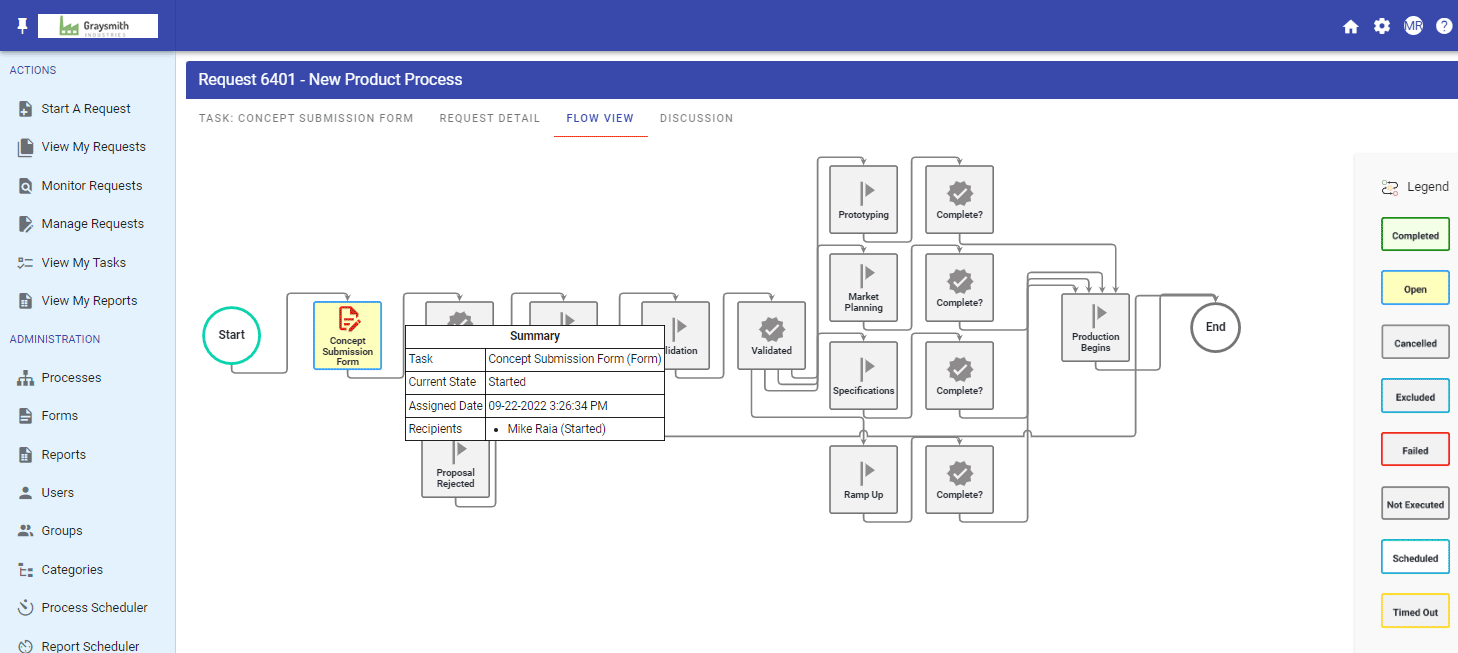
Integrify stands as a powerful workflow management and automation software, distinctively designed to automate business processes without the need for coding.
Why Integrify Makes the Cut: The decision to include Integrify in this selection stems from its ability to empower organizations to construct automated processes, design dynamic forms, and establish self-service portals efficiently. A notable aspect of Integrify is its capability to provide performance insights through detailed reports and dashboards. The audit trails feature is particularly commendable, offering teams an easy way to review activities and pinpoint issues, enhancing overall process transparency and accountability.
The platform is tailored to both large and small businesses, with a focus on rapid implementation and scalability. Through my research, it became evident that Integrify is exceptionally beneficial in providing enhanced visibility into workflow processes in key business areas such as IT, HR, sales, operations, and finance. Offering versatility, the software is available in cloud-based, private cloud, and on-premise configurations, catering to diverse IT infrastructure needs.
Integrify’s Notable Features & Integrations:
- Robust Process Builder: Integrify boasts a user-friendly process builder with drag-and-drop functionality, making workflow creation straightforward. Additional features like notes, comments, task dependency previews, multi-tiered approvals, reminders, and timeouts further enrich the user experience.
- Seamless Integrations: With its open API, Integrify offers effortless connectivity to ERP, CRM, and HRIS systems. This integration capability ensures smooth data transfer between systems, crucial for effective automated workflows.
In conclusion, Integrify emerges as a versatile and efficient solution for businesses seeking a comprehensive workflow management tool. Its combination of ease of use, robust features, and broad integration capabilities make it a standout choice for enhancing workflow efficiency and process visibility.
#8: Smartsheet
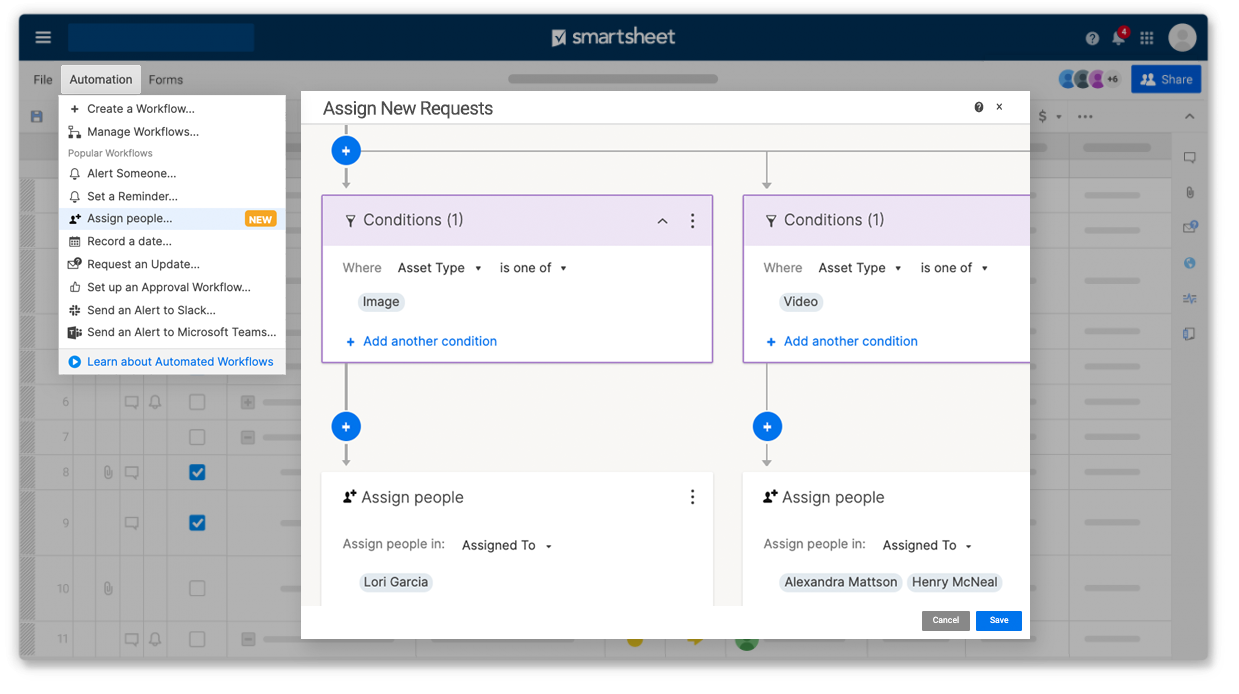
Smartsheet stands out as an intuitive workflow management software, drawing its design and functionality inspiration from spreadsheets. This tool is tailored for users who find comfort in the familiar environment of Excel but wish to avoid its complex formulas. Smartsheet simplifies task organization, scheduling, and process management, all within a user-friendly, spreadsheet-like interface. Recognized with several awards, Smartsheet has quickly become a preferred tool in the business world, particularly for those seeking simplicity combined with powerful capabilities.
Key Features and Benefits of Smartsheet:
- Efficient Project Planning and Management: Smartsheet enables users to standardize essential project components, enhancing speed and collaboration. Its scalable solutions adapt to various individual work preferences.
- Dynamic Portfolio Management: Offering a comprehensive view, it allows effective management of projects, portfolios, and resources, thereby increasing agility and improving project delivery quality.
- Enhanced Program Planning and Execution: Empower your teams for quicker, accountable collaboration, driving swifter and more successful project outcomes.
- Real-time Project Insights: Smartsheet enhances reporting capabilities with immediate, detailed metrics that summarize task progress, boosting stakeholder confidence.
- Seamless Integration: It integrates effortlessly with a wide array of enterprise systems and applications, ensuring all team members have the necessary real-time insights for innovative and dynamic execution.
- Critical Path Identification: A key feature of Smartsheet is its ability to highlight tasks that are crucial to the project’s completion, helping to focus on important milestones.
- Accessible Pricing: Smartsheet offers a cost-effective solution at $7 per user per month, catering to small to medium-sized teams, with a minimum of 3 and a maximum of 25 users. Additionally, a 30-day free trial allows users to experience its features firsthand.
In summary, Smartsheet is a versatile, easy-to-use tool that brings the simplicity of spreadsheet management to complex workflow automation and project management, making it an excellent choice for businesses seeking efficient and agile workflow solutions.
#9: Jotform
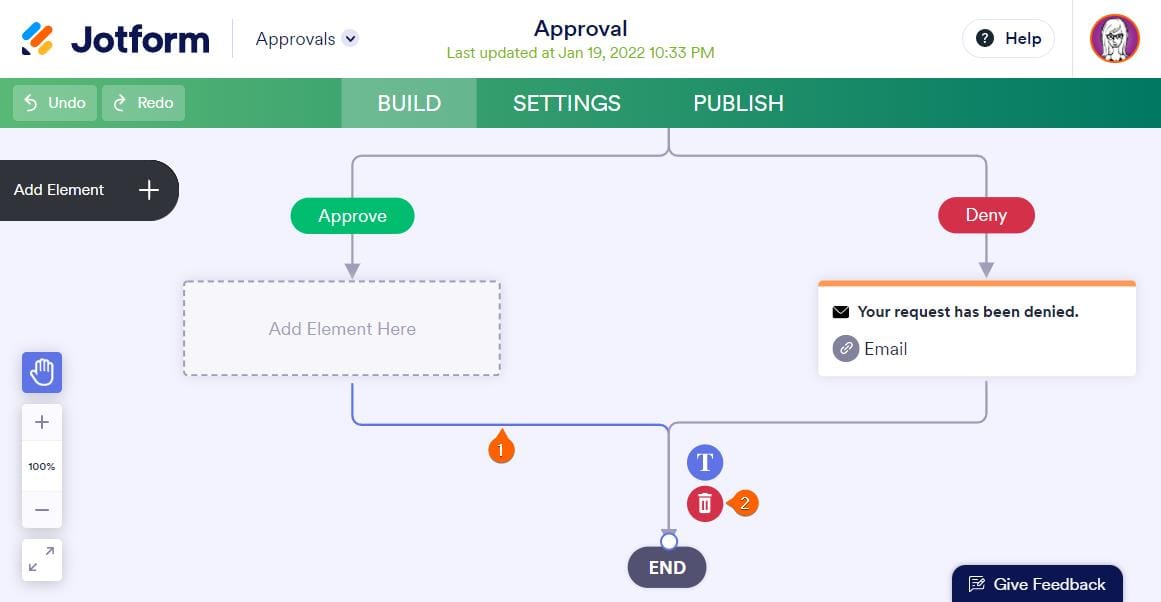
Jotform Enterprise emerges as a robust and user-friendly solution for data collection, designed to optimize workflow automation for businesses across various sectors. It is particularly adept at providing tools for offline forms, product feedback surveys, collaboration, and approvals for automated workflows, with a specialization in B2B applications yet adaptable to diverse customer markets and industries.
Why Jotform Enterprise ?: The platform’s versatility is commendable, offering the capability to build complex, customized systems to meet specific business requirements. A key reason for selecting Jotform Enterprise is its intuitive form builder. This feature enables the rapid creation of various forms, ranging from customer data collection to project tracking for employees. The builder is equipped with hundreds of customizable templates, simplifying the form creation process. Whether it’s designing an order form integrated with payment services or setting up automated email notifications, Jotform Enterprise offers seamless functionality.
Distinguished Features & Integrations of Jotform Enterprise:
- In-depth Analytics: The platform boasts powerful analytics tools, enabling real-time monitoring of customer interactions with forms. Users can track metrics like page views, submission times, and abandonment rates, providing insights to enhance the form process and customer experience.
- Flexible Hosting Options: Jotform Enterprise can be hosted across various platforms, offering compliance with local data privacy regulations, a critical consideration in today’s digital landscape.
- Extensive Integrations: The platform integrates with a range of services including Google Drive, Google Sheets, Slack, Dropbox, PayPal, Stripe, Salesforce, Mailchimp, and Airtable. Additionally, through Zapier, Jotform can connect with over 1,000 other apps and services, although this may require a separate Zapier account and could involve additional costs.
In summary, Jotform Enterprise stands out as a highly adaptable and efficient tool for businesses seeking to enhance their workflow automation through advanced data collection and analysis. Its combination of an easy-to-use form builder, powerful analytics, and wide integration capabilities makes it a valuable asset for businesses looking to streamline processes and gain deeper customer insights.
#10: Sysaid

SysAid emerges as a comprehensive service desk and IT service management (ITSM) software, tailored to assist businesses in streamlining their IT services and managing workflows with greater efficiency. My research indicates that SysAid offers a robust set of tools encompassing incident and request management, problem and change management, and IT asset management, making it a well-rounded platform for IT service optimization.
Why SysAid ?: The selection of SysAid for this list is driven by its exceptional customizability and scalability. This adaptability makes it suitable for a wide range of businesses, from small startups to large corporations. A standout feature of SysAid is its workflow automation system that integrates AI and machine learning. This advanced technology aids in recognizing patterns and proactively managing tasks, such as intelligently assigning tickets to the most suitable support agent or escalating issues as necessary. Additionally, SysAid enhances IT asset management with features like barcode scanning, streamlining the entire lifecycle management of assets and ensuring greater accuracy.
SysAid’s Distinguished Features & Integrations:
- Efficient Incident Management and Ticket Tracking: SysAid offers a self-service incident management system, allowing users to track the status of their service requests and incidents via a self-service portal. This feature ensures transparency and provides real-time visibility, keeping users informed and ensuring prompt resolution of their issues.
- Gamification for Enhanced Engagement: The incorporation of gamification elements within SysAid serves to elevate user engagement. It boosts productivity, fosters teamwork, and instills a sense of achievement among IT staff, contributing to a more motivated and effective team.
- Broad Range of Integrations: SysAid seamlessly integrates with numerous platforms, including Slack, Jira, Microsoft Teams, Nagios, SolarWinds, Zabbix, ServiceNow, TeamViewer, Remote Desktop Protocol (RDP), and Active Directory (AD). These integrations extend the functionality and applicability of SysAid, making it a versatile choice for diverse IT environments.
In summary, SysAid stands out as a versatile and powerful ITSM software, equipped with a range of features and integrations that cater to the varied needs of modern businesses. Its focus on automation, scalability, and user engagement makes it a compelling option for those seeking to optimize their IT service management and workflow processes.
Potential Use Cases for Workflow Automation
- HR Onboarding Process: Human resources departments utilize workflow automation software to simplify the onboarding of new employees. With automation, the software generates welcome emails, grants access to necessary documents and resources, schedules training sessions, and automatically notifies relevant departments about the arrival of new hires. This streamlines the traditionally time-consuming onboarding process and ensures that it proceeds smoothly and efficiently.
You may read more about HR optimization on the following blogs: https://nanonets.com/blog/hr-automation-in-2023/ , https://nanonets.com/blog/best-interview-scheduling-software-in-2023/,
https://nanonets.com/blog/leave-management/. - Invoice Processing: Finance departments rely on workflow automation tools to optimize the invoice processing workflow. When an invoice is received, the automation software automatically scans and digitizes it, matches it to a corresponding purchase order, routes it through the appropriate approval channels, and, upon approval, triggers the payment process. This automation reduces manual data entry, minimizes errors, and accelerates payment cycles.
- Customer Support Ticketing: Customer support teams employ workflow automation to manage and prioritize support tickets effectively. The automation tool assigns incoming tickets to available support agents, sends predefined responses for common issues, and escalates complex or high-priority cases to senior support staff automatically. This ensures timely responses and efficient issue resolution.
- Marketing Campaigns: Marketing departments utilize workflow automation to orchestrate and execute marketing campaigns with precision. The tool can schedule email deployments, post social media updates, track customer interactions, and segment leads based on their engagement level. This automation enhances the consistency and effectiveness of marketing efforts while reducing manual effort.
Example of few Marketing Integrations available on Nanonets:
Apollo.io, Gmail, Whatsapp, Facebook Ads and many more. - IT Service Requests: IT departments leverage workflow automation to handle service requests efficiently. When employees request IT support, the automation software categorizes and prioritizes requests, assigns them to appropriate IT personnel, tracks their progress, and notifies requesters upon resolution. This streamlined approach minimizes downtime and enhances user satisfaction.
- Sales Lead Management: Sales teams employ workflow automation to efficiently manage leads and prospects. The software assigns incoming leads to specific sales representatives based on predefined criteria, and it can trigger automated follow-up actions such as sending follow-up emails, scheduling calls, or updating lead statuses. This ensures that leads are promptly and consistently nurtured through the sales pipeline.
- Content Approval and Publishing: Content creation teams benefit from workflow automation for content approval and publishing processes. Content goes through multiple rounds of editing and approvals, and the automation tool helps manage the workflow by notifying stakeholders, tracking the status of each content piece, and ensuring that content is published on schedule. This streamlined approach improves content production efficiency and coordination among team members.
- Inventory Management: Supply chain and inventory management departments use workflow automation to optimize stock levels. The system can automatically reorder items when inventory reaches predefined thresholds, create purchase orders, and update inventory records. This ensures that goods are consistently available to meet demand while minimizing excess inventory costs.
Nanonets workflows can optimize your business performance, save costs and boost growth. See how Nanonets’ use cases can apply to your product.
Conclusion
In conclusion, Workflow Automation is not just a buzzword; it’s a transformative approach that has the potential to revolutionize how businesses operate in the digital age. By automating repetitive tasks, streamlining complex processes, and improving overall efficiency, organizations can unlock a new level of productivity and innovation.
In this blog, we’ve explored the fundamentals of Workflow Automation, understanding its purpose in modern business landscapes, and its role in reducing manual work while enhancing accuracy and consistency. We’ve also delved into the key benefits it brings, such as time and cost savings, improved compliance, and enhanced collaboration among teams.
Furthermore, we’ve introduced you to five of the best Workflow Automation Software solutions available in 2023, each with its unique strengths and capabilities. From the no-code simplicity of Zapier to the AI-driven power of Nanonets, these tools offer a range of options to suit different business needs.
As you embark on your journey into Workflow Automation, it’s essential to carefully assess your organization’s requirements, processes, and goals. Choose the right software that aligns with your specific needs, and remember that automation is not just about saving time—it’s about enabling your teams to focus on what truly matters: innovation, creativity, and delivering exceptional value to your customers.
Use a no-code platform to process all your documents on autopilot with intelligent workflow automation. Interested?



